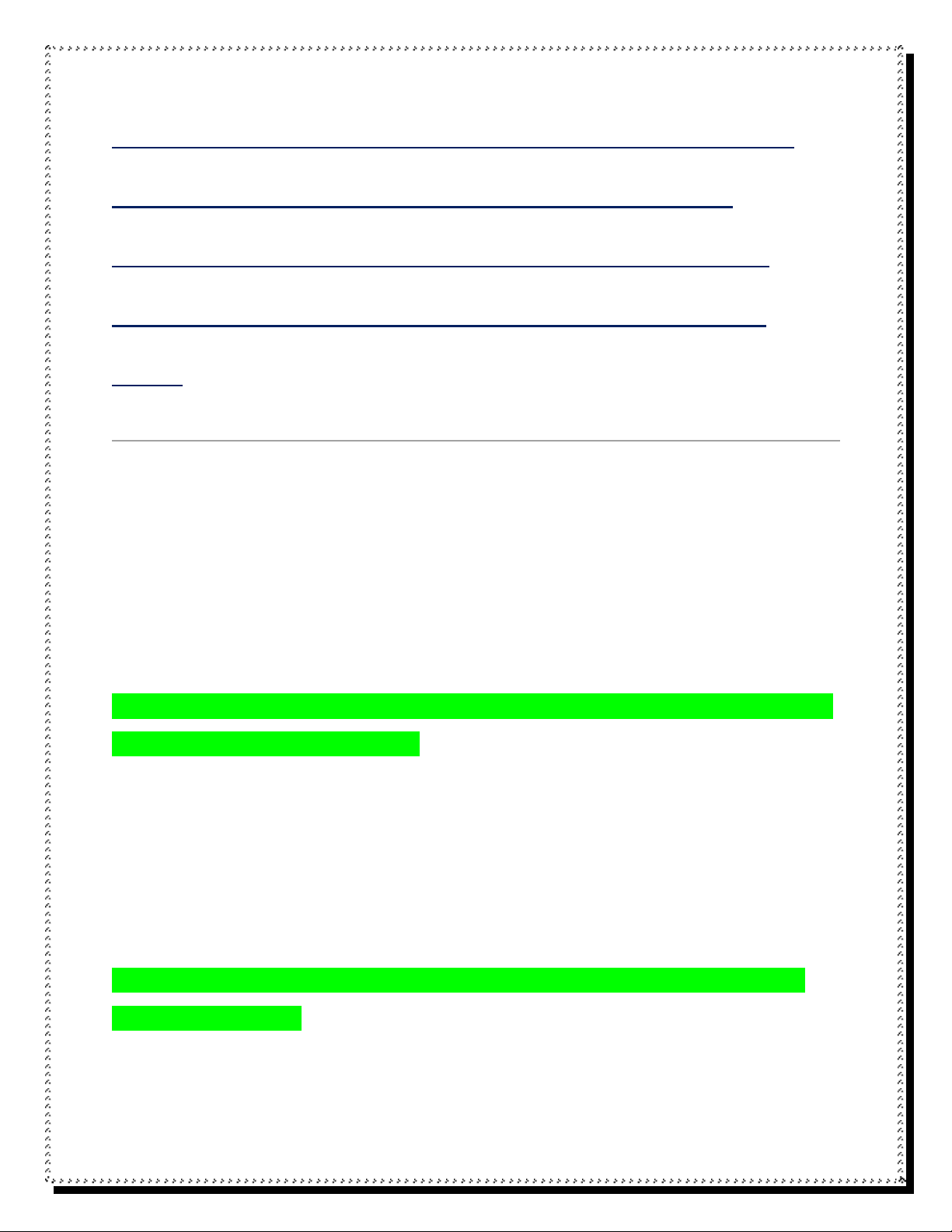
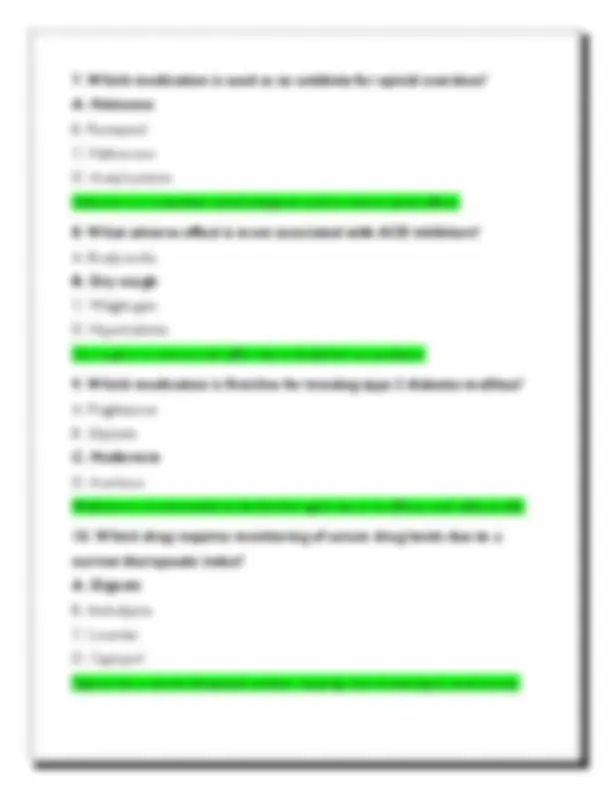
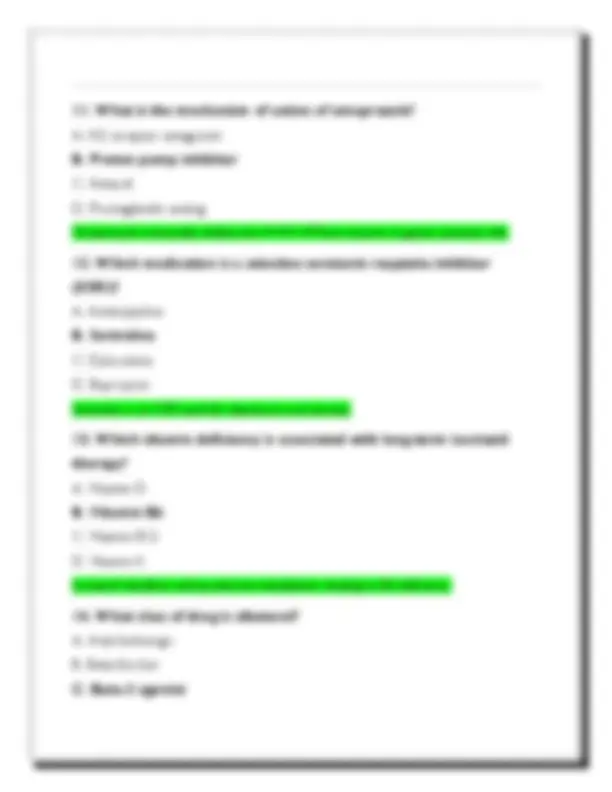
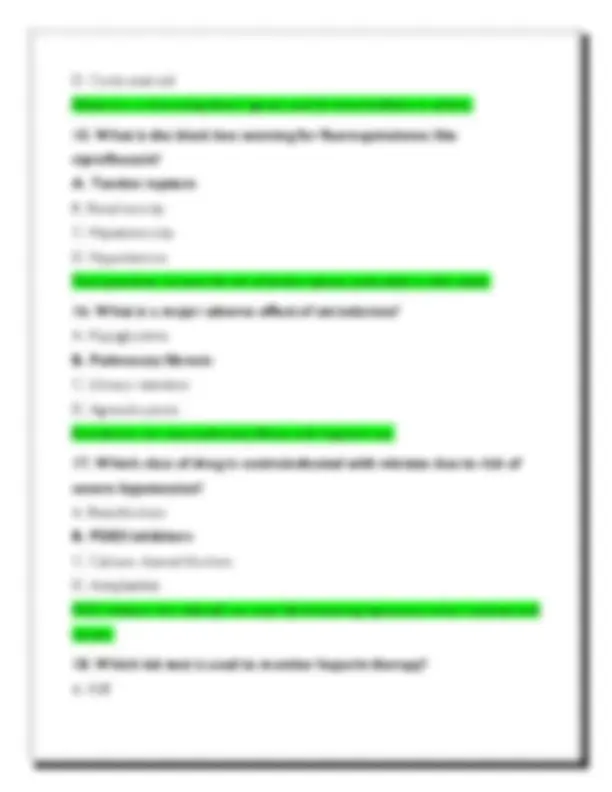
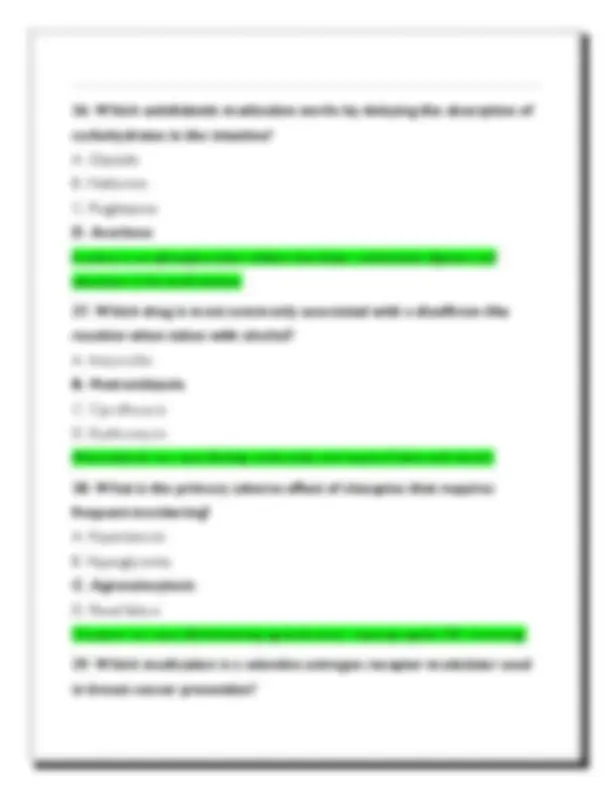
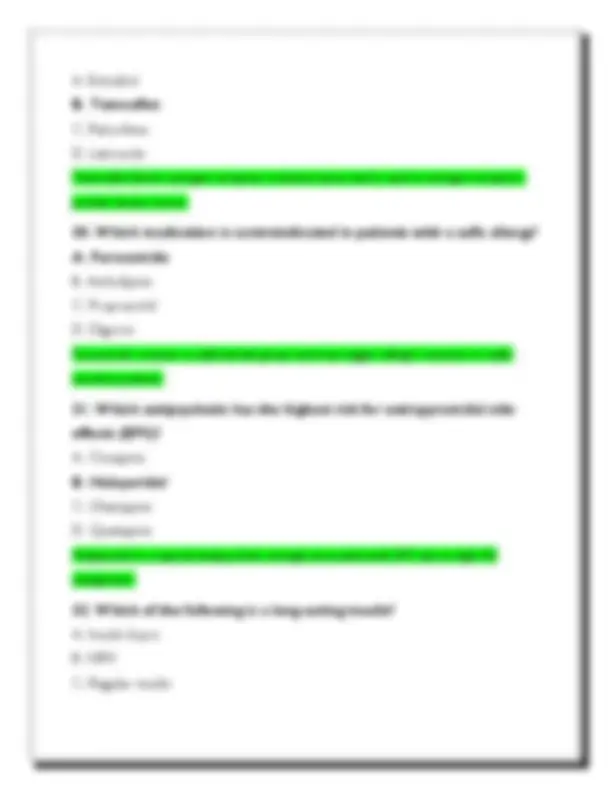
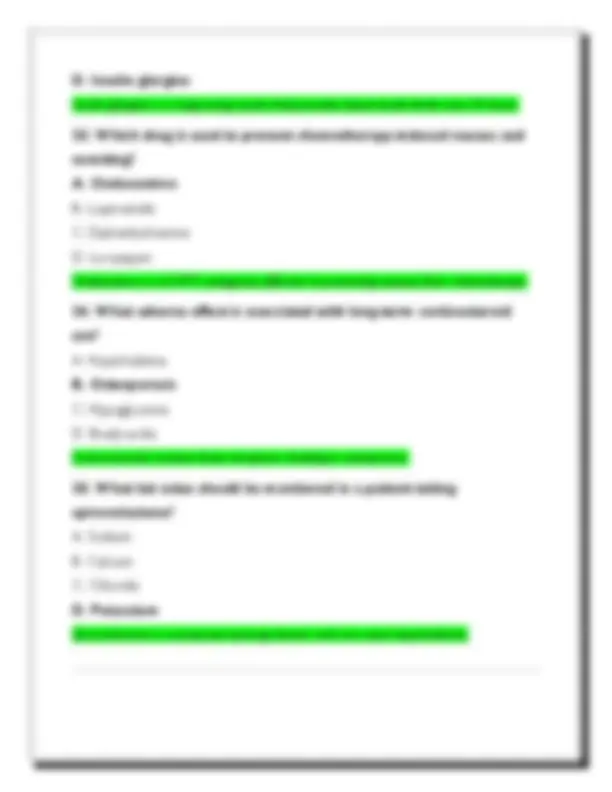
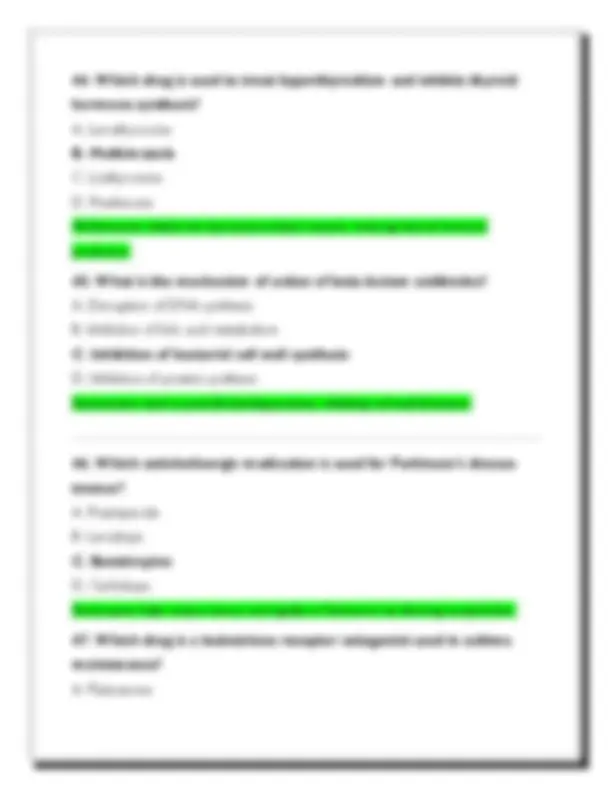
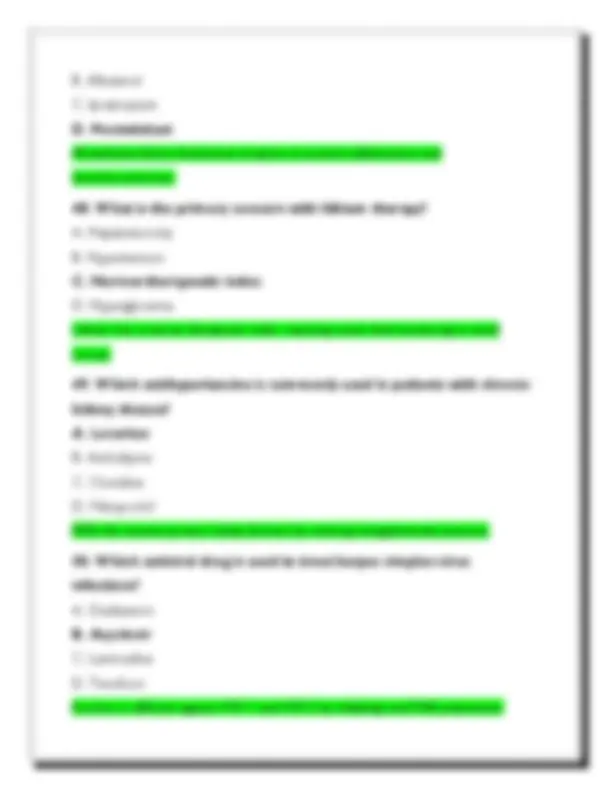
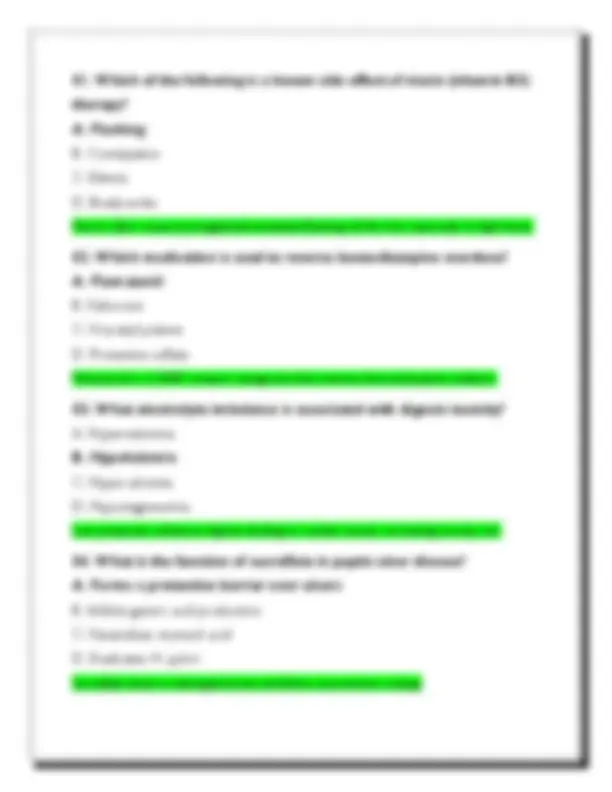
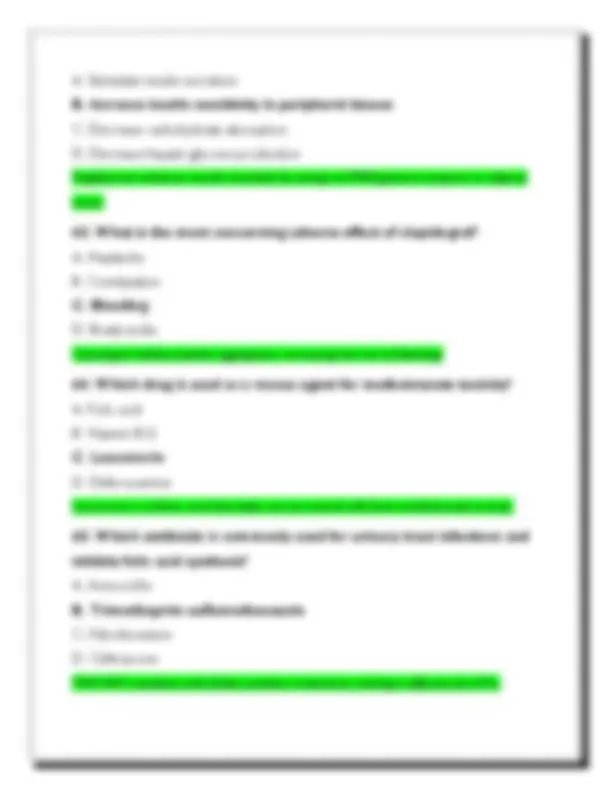
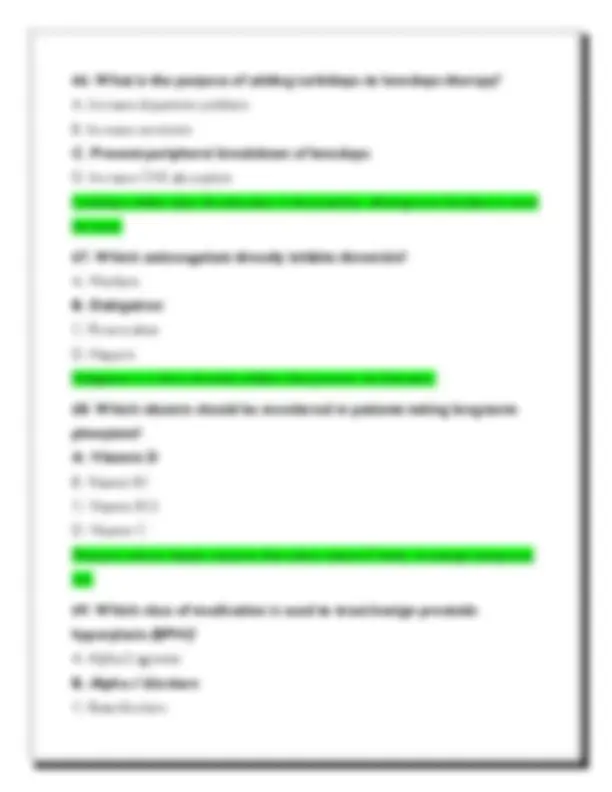
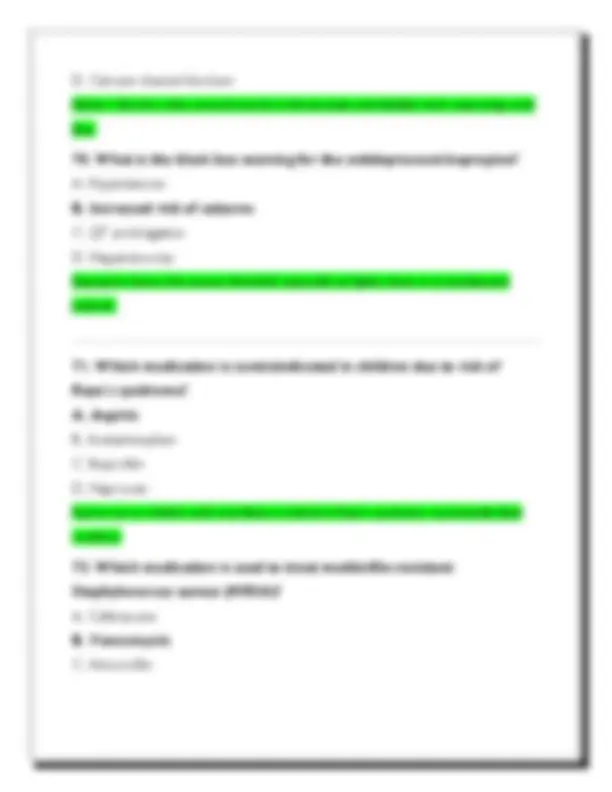
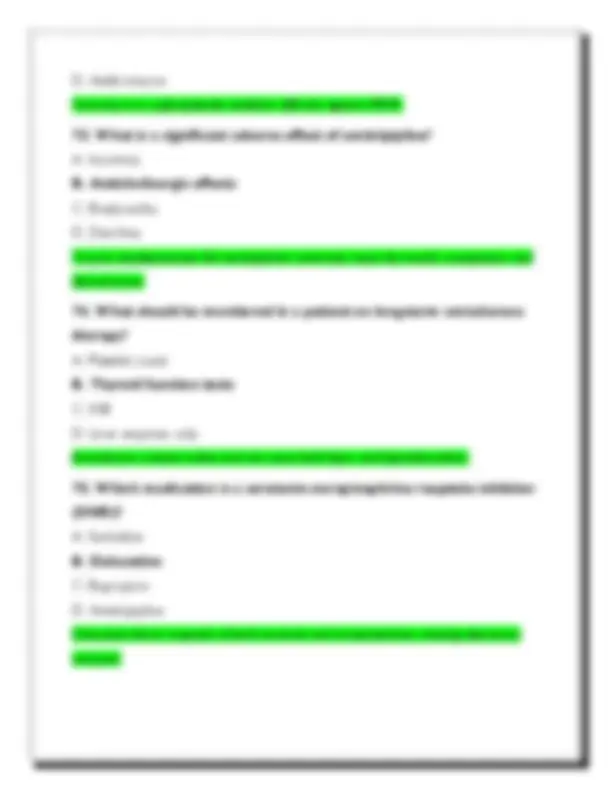

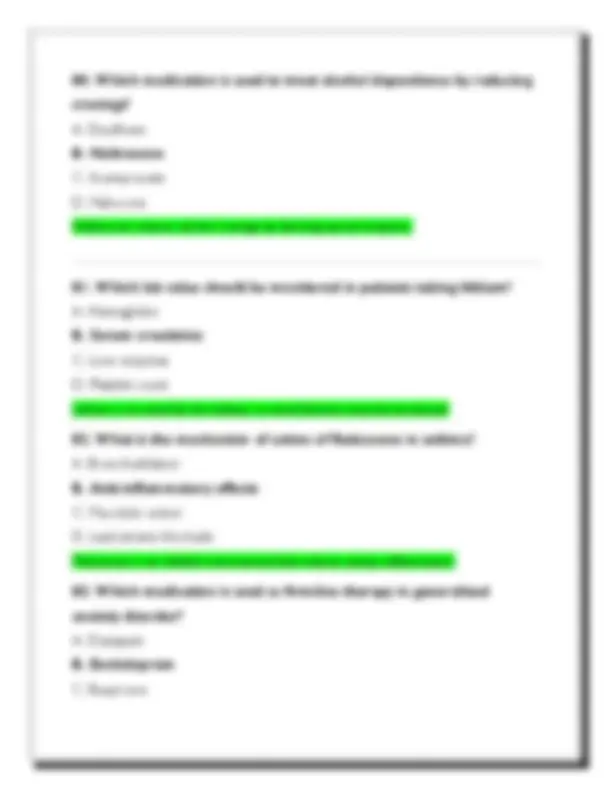
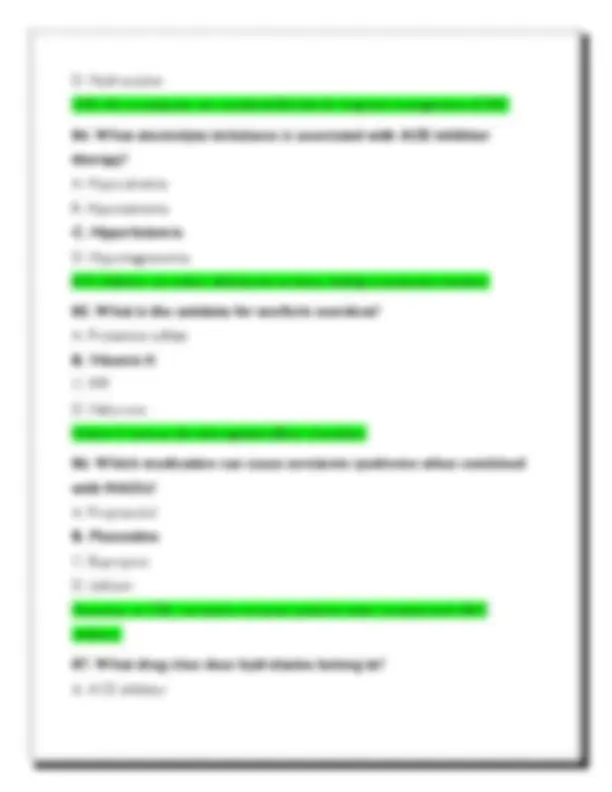
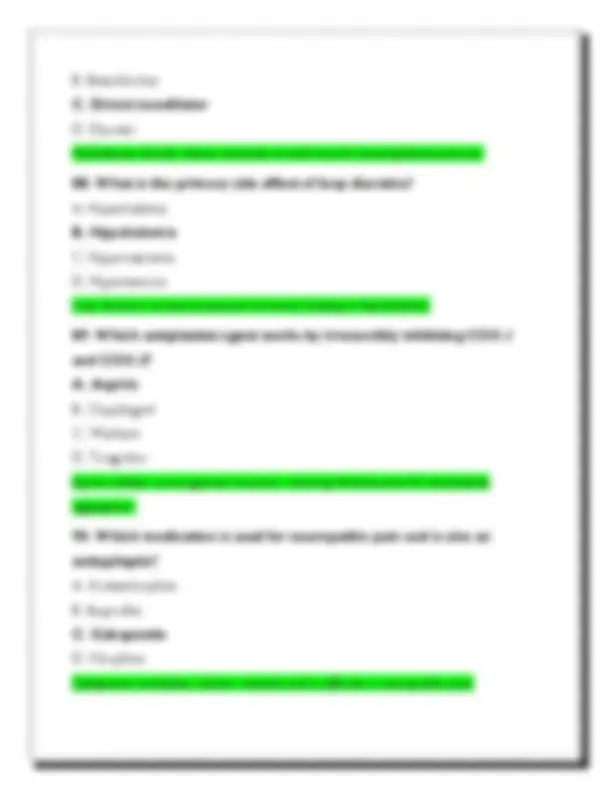
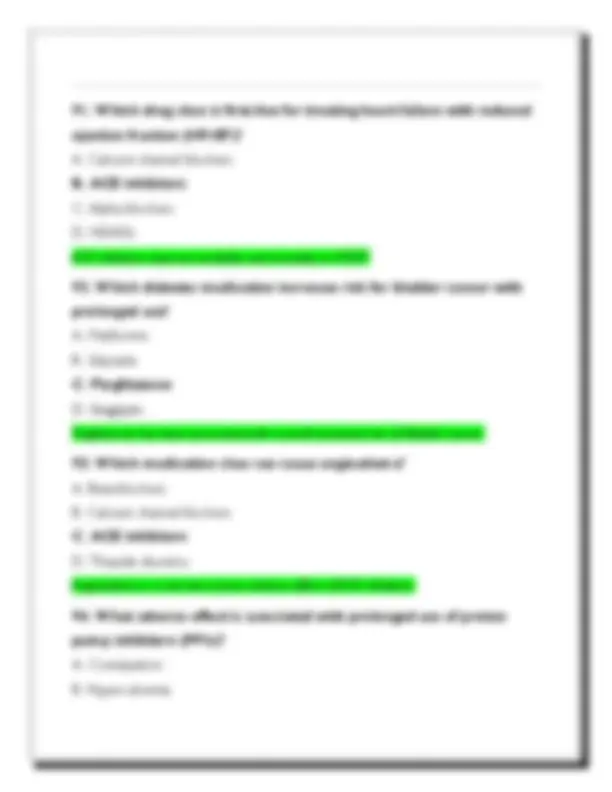
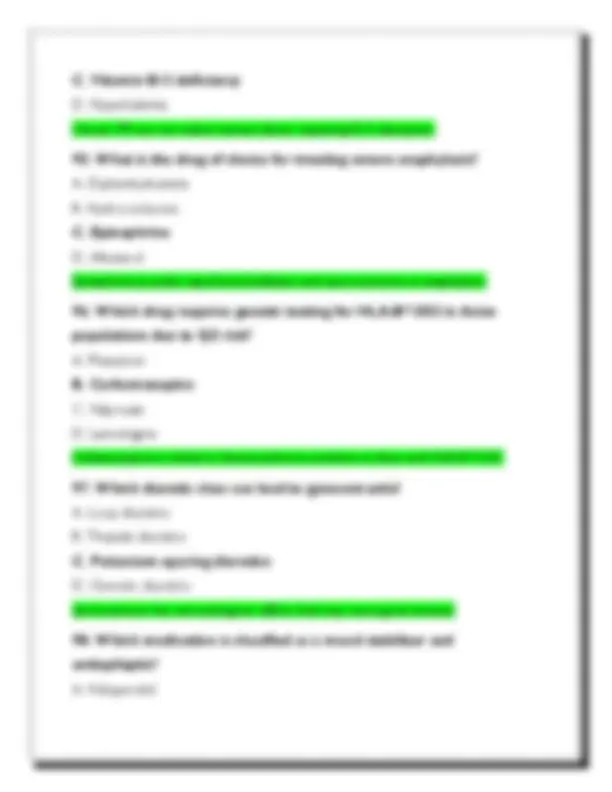
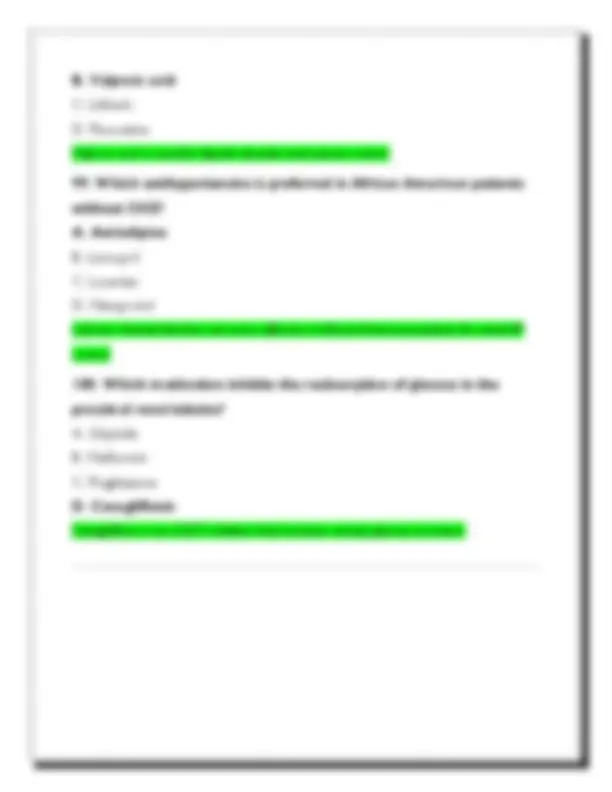


Study with the several resources on Docsity

Earn points by helping other students or get them with a premium plan


Prepare for your exams
Study with the several resources on Docsity

Earn points to download
Earn points by helping other students or get them with a premium plan
Community
Ask the community for help and clear up your study doubts
Discover the best universities in your country according to Docsity users
Free resources
Download our free guides on studying techniques, anxiety management strategies, and thesis advice from Docsity tutors
MSN NSG 5150 Advanced Pharmacology – Cumulative Final Exam Questions And Correct Answers (Verified Answers) Plus Rationales 2025 Q&A | Instant Download PDF
Typology: Exams
1 / 28

This page cannot be seen from the preview
Don't miss anything!





















1. Which of the following antihypertensive medications is contraindicated in pregnancy? A. Methyldopa B. Lisinopril C. Nifedipine D. Hydralazine ACE inhibitors like lisinopril are teratogenic and can cause fetal renal damage; thus, they are contraindicated during pregnancy. 2. What is the primary mechanism of action of loop diuretics? A. Inhibition of the sodium-potassium ATPase pump B. Inhibition of the Na-K-2Cl symporter in the loop of Henle C. Blocking aldosterone receptors in the distal tubule D. Inhibiting carbonic anhydrase in the proximal tubule Loop diuretics act by inhibiting the Na-K-2Cl symporter in the thick ascending loop of Henle, causing diuresis. 3. Which antibiotic is associated with ototoxicity and nephrotoxicity? A. Ceftriaxone
B. Azithromycin C. Gentamicin D. Amoxicillin Gentamicin, an aminoglycoside, has known risks of oto- and nephrotoxicity, especially with prolonged use.
4. A patient is taking warfarin. Which medication increases the risk of bleeding when taken concurrently? A. Metronidazole B. Atorvastatin C. Omeprazole D. Lisinopril Metronidazole inhibits warfarin metabolism, increasing INR and bleeding risk. 5. Which drug class does metoprolol belong to? A. Alpha-blockers B. Beta-1 selective blockers C. Non-selective beta blockers D. Calcium channel blockers Metoprolol selectively blocks beta-1 adrenergic receptors, making it cardioselective. 6. Which insulin has the fastest onset of action? A. NPH B. Insulin lispro C. Insulin glargine D. Regular insulin Insulin lispro is a rapid-acting insulin with onset within 15 minutes.
11. What is the mechanism of action of omeprazole? A. H2 receptor antagonist B. Proton pump inhibitor C. Antacid D. Prostaglandin analog Omeprazole irreversibly inhibits the H+/K+ ATPase enzyme in gastric parietal cells. 12. Which medication is a selective serotonin reuptake inhibitor (SSRI)? A. Amitriptyline B. Sertraline C. Duloxetine D. Bupropion Sertraline is an SSRI used for depression and anxiety. 13. Which vitamin deficiency is associated with long-term isoniazid therapy? A. Vitamin D B. Vitamin B C. Vitamin B D. Vitamin K Isoniazid interferes with pyridoxine metabolism, leading to B6 deficiency. 14. What class of drug is albuterol? A. Anticholinergic B. Beta-blocker C. Beta- 2 agonist
D. Corticosteroid Albuterol is a short-acting beta-2 agonist used for bronchodilation in asthma.
15. What is the black box warning for fluoroquinolones like ciprofloxacin? A. Tendon rupture B. Renal toxicity C. Hepatotoxicity D. Hypertension Fluoroquinolones increase the risk of tendon rupture, particularly in older adults. 16. What is a major adverse effect of amiodarone? A. Hypoglycemia B. Pulmonary fibrosis C. Urinary retention D. Agranulocytosis Amiodarone can cause pulmonary fibrosis with long-term use. 17. Which class of drug is contraindicated with nitrates due to risk of severe hypotension? A. Beta-blockers B. PDE5 inhibitors C. Calcium channel blockers D. Antiplatelets PDE5 inhibitors like sildenafil can cause life-threatening hypotension when combined with nitrates. 18. Which lab test is used to monitor heparin therapy? A. INR
B. Phenytoin C. Valproic acid D. Levetiracetam Phenytoin is associated with gingival overgrowth, especially with poor dental hygiene.
23. What is the antidote for acetaminophen overdose? A. Naloxone B. N-acetylcysteine C. Atropine D. Flumazenil N-acetylcysteine replenishes glutathione and prevents liver damage in acetaminophen overdose. 24. Which statin is most associated with rhabdomyolysis? A. Pravastatin B. Simvastatin C. Rosuvastatin D. Fluvastatin Simvastatin, especially in high doses or with CYP3A4 inhibitors, has a higher risk of rhabdomyolysis. 25. Which medication is a thiazide diuretic? A. Furosemide B. Hydrochlorothiazide C. Spironolactone D. Acetazolamide Hydrochlorothiazide works in the distal tubule to promote diuresis and decrease blood pressure.
26. Which antidiabetic medication works by delaying the absorption of carbohydrates in the intestine? A. Glipizide B. Metformin C. Pioglitazone D. Acarbose Acarbose is an alpha-glucosidase inhibitor that delays carbohydrate digestion and absorption in the small intestine. 27. Which drug is most commonly associated with a disulfiram-like reaction when taken with alcohol? A. Amoxicillin B. Metronidazole C. Ciprofloxacin D. Erythromycin Metronidazole can cause flushing, tachycardia, and nausea if taken with alcohol. 28. What is the primary adverse effect of clozapine that requires frequent monitoring? A. Hypertension B. Hyperglycemia C. Agranulocytosis D. Renal failure Clozapine can cause life-threatening agranulocytosis, requiring regular CBC monitoring. 29. Which medication is a selective estrogen receptor modulator used in breast cancer prevention?
D. Insulin glargine Insulin glargine is a long-acting insulin that provides basal insulin levels over 24 hours.
33. Which drug is used to prevent chemotherapy-induced nausea and vomiting? A. Ondansetron B. Loperamide C. Diphenhydramine D. Lorazepam Ondansetron is a 5-HT3 antagonist effective in preventing nausea from chemotherapy. 34. What adverse effect is associated with long-term corticosteroid use? A. Hyperkalemia B. Osteoporosis C. Hypoglycemia D. Bradycardia Corticosteroids increase bone resorption, leading to osteoporosis. 35. What lab value should be monitored in a patient taking spironolactone? A. Sodium B. Calcium C. Chloride D. Potassium Spironolactone is a potassium-sparing diuretic and can cause hyperkalemia.
36. Which medication is used to treat myasthenia gravis? A. Atropine B. Diazepam C. Pyridostigmine D. Phenytoin Pyridostigmine is an acetylcholinesterase inhibitor that improves neuromuscular transmission. 37. Which antibiotic can cause tooth discoloration in children under 8 years old? A. Erythromycin B. Amoxicillin C. Doxycycline D. Cephalexin Doxycycline, a tetracycline, deposits in developing teeth and bones, causing discoloration. 38. Which medication is indicated for acute gout attacks? A. Allopurinol B. Colchicine C. Probenecid D. Febuxostat Colchicine reduces inflammation and is effective during acute gout flares. 39. What is the main action of HMG-CoA reductase inhibitors (statins)? A. Increase triglyceride breakdown B. Inhibit cholesterol synthesis in the liver C. Bind to bile acids D. Increase LDL receptors in adipose tissue Statins inhibit the enzyme HMG-CoA reductase, decreasing hepatic cholesterol synthesis.
44. Which drug is used to treat hyperthyroidism and inhibits thyroid hormone synthesis? A. Levothyroxine B. Methimazole C. Liothyronine D. Prednisone Methimazole inhibits the thyroid peroxidase enzyme, reducing thyroid hormone production. 45. What is the mechanism of action of beta-lactam antibiotics? A. Disruption of DNA synthesis B. Inhibition of folic acid metabolism C. Inhibition of bacterial cell wall synthesis D. Inhibition of protein synthesis Beta-lactams bind to penicillin-binding proteins, inhibiting cell wall formation. 46. Which anticholinergic medication is used for Parkinson's disease tremor? A. Pramipexole B. Levodopa C. Benztropine D. Carbidopa Benztropine helps reduce tremor and rigidity in Parkinson's by blocking acetylcholine. 47. Which drug is a leukotriene receptor antagonist used in asthma maintenance? A. Fluticasone
B. Albuterol C. Ipratropium D. Montelukast Montelukast blocks leukotriene receptors to prevent inflammation and bronchoconstriction.
48. What is the primary concern with lithium therapy? A. Hepatotoxicity B. Hypertension C. Narrow therapeutic index D. Hyperglycemia Lithium has a narrow therapeutic index, requiring serum level monitoring to avoid toxicity. 49. Which antihypertensive is commonly used in patients with chronic kidney disease? A. Losartan B. Amlodipine C. Clonidine D. Metoprolol ARBs like losartan protect kidney function by reducing intraglomerular pressure. 50. Which antiviral drug is used to treat herpes simplex virus infections? A. Oseltamivir B. Acyclovir C. Lamivudine D. Tenofovir Acyclovir is effective against HSV-1 and HSV-2 by inhibiting viral DNA polymerase.
55. Which medication is contraindicated with concurrent use of nitrates? A. Atorvastatin B. Amlodipine C. Sildenafil D. Warfarin Sildenafil and nitrates both dilate vessels, which may lead to life-threatening hypotension. 56. What is the recommended treatment for severe iron overdose in children? A. Activated charcoal B. Deferoxamine C. Naloxone D. Vitamin K Deferoxamine binds free iron and promotes excretion in iron toxicity. 57. Which antiepileptic medication is also used for migraine prophylaxis? A. Phenytoin B. Valproic acid C. Topiramate D. Gabapentin Topiramate is FDA-approved for both seizure control and migraine prevention. 58. What is the primary use of alendronate? A. Treating anemia B. Managing asthma C. Preventing bone loss
D. Treating hypertension Alendronate is a bisphosphonate used to increase bone density in osteoporosis.
59. Which lab must be monitored in a patient taking methotrexate? A. Potassium B. Calcium C. Liver function tests D. Sodium Methotrexate is hepatotoxic and requires regular LFT monitoring. 60. What is a major concern with clindamycin use? A. Renal failure B. C. difficile-associated diarrhea C. Agranulocytosis D. Seizures Clindamycin disrupts gut flora and increases the risk of C. difficile infection. 61. Which of the following medications is a dopamine agonist used in Parkinson’s disease? A. Levodopa B. Pramipexole C. Benztropine D. Carbidopa Pramipexole stimulates dopamine receptors and helps reduce motor symptoms in Parkinson’s disease. 62. What is the mechanism of action of thiazolidinediones such as pioglitazone?
66. What is the purpose of adding carbidopa to levodopa therapy? A. Increase dopamine synthesis B. Increase serotonin C. Prevent peripheral breakdown of levodopa D. Increase CNS absorption Carbidopa inhibits dopa decarboxylase in the periphery, allowing more levodopa to reach the brain. 67. Which anticoagulant directly inhibits thrombin? A. Warfarin B. Dabigatran C. Rivaroxaban D. Heparin Dabigatran is a direct thrombin inhibitor that prevents clot formation. 68. Which vitamin should be monitored in patients taking long-term phenytoin? A. Vitamin D B. Vitamin B C. Vitamin B D. Vitamin C Phenytoin induces hepatic enzymes that reduce vitamin D levels, increasing osteoporosis risk. 69. Which class of medication is used to treat benign prostatic hyperplasia (BPH)? A. Alpha-2 agonists B. Alpha-1 blockers C. Beta-blockers
D. Calcium channel blockers Alpha-1 blockers relax smooth muscle in the prostate and bladder neck, improving urine flow.
70. What is the black box warning for the antidepressant bupropion? A. Hypertension B. Increased risk of seizures C. QT prolongation D. Hepatotoxicity Bupropion lowers the seizure threshold, especially at higher doses or in predisposed patients. 71. Which medication is contraindicated in children due to risk of Reye’s syndrome? A. Aspirin B. Acetaminophen C. Ibuprofen D. Naproxen Aspirin use in children with viral illness is linked to Reye’s syndrome, a potentially fatal condition. 72. Which medication is used to treat methicillin-resistant Staphylococcus aureus (MRSA)? A. Ceftriaxone B. Vancomycin C. Amoxicillin